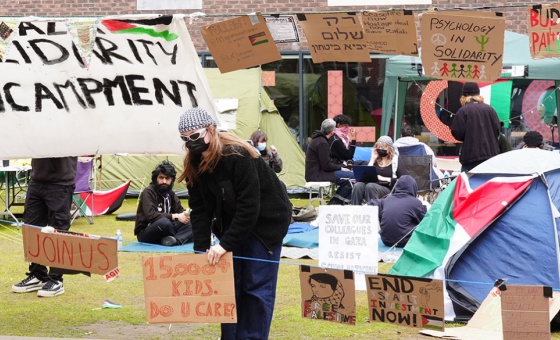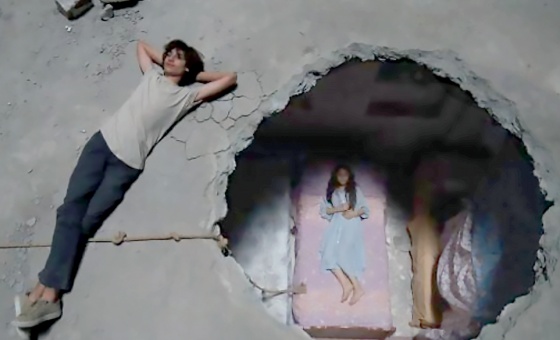This is the last article you can read this month
You can read more article this month
You can read more articles this month
Sorry your limit is up for this month
Reset on:
Please help support the Morning Star by subscribing here
THE humanitarian impact of Israel’s attack on Gaza is difficult to comprehend. Not only the bombardment but the severe restriction of aid into Gaza has killed tens of thousands of people.
Most awfully, these factors often combine, as on February 29. A crowd of desperate Palestinian civilians had gathered to wait for an aid convoy delivering bags of flour when Israeli troops fired into the crowd for a reported hour and a half. At least 118 civilians died in the “Flour Massacre,” as the event has been dubbed, with hundreds more injured.
As Al-Jazeera reported, though there is dispute over what led the Israeli forces to fire, the basic facts are clear: “Israeli forces fired indiscriminately into the crowd which killed dozens of people and led to a stampede in which more people died.”
The blockade imposed by Israel on the Gaza Strip over the last 17 years has meant that civilians living there are heavily reliant on humanitarian aid, even under the appalling “normal” conditions of occupation.
The blocking of aid is a violation of international order. Israel has been accused of going against the ruling of the International Court of Justice, with a spokesperson for Human Rights Watch saying that “the Israeli government has simply ignored the court’s ruling, and in some ways even intensified its repression.”
At the level of the individual, conflict is terrifyingly unpredictable. Hossam Abu Shaar, who was waiting for flour during the attack on February 29, felt the wind of bullets passing him by. He didn’t know if he would survive.
Though he was injured when shrapnel from an artillery shell hit his leg, he survived and got a bag of flour while many surrounding him died.
“This bag of flour turned out to cost the life of its bearer,” he said. “It’s the most expensive food ever made.”
But at another level, the effects of conflict are grimly predictable. Military attacks are planned and intentionally implemented. Cutting off aid and other vital resources (water, electricity, fuel, telecommunications) has defined and predictable consequences.
While a prediction for any individual is impossible, the statistical analysis of death rates in this way is familiar to researchers who model the impact of infectious disease. These epidemiologists can even use the same sorts of models used for infectious disease to forecast the overall numbers of deaths in this military attack under different scenarios.
That’s what an ongoing project is doing. Researchers at the London School of Hygiene and Tropical Medicine are collaborating with researchers at Johns Hopkins University in the US on “scenario-based health impact projections” for Gaza.
In modelling parlance, a “projection” is not a prediction, but rather what is likely to happen under a particular scenario. The probability of the particular scenario occurring is not part of the modelling.
For example, researchers could produce projections for the impact of an outbreak of a new infectious disease which killed 50 per cent of those it infected, without claiming that such a disease exists or is likely to emerge.
The researchers modelled three distinct scenarios in the Gaza projections: an immediate permanent ceasefire; a continuation of the status quo; or a further escalation of the conflict. Crucially, these are not simply models of death by injury from artillery.
The model shows how military attacks kill people through other ways too. The team modelled “excess deaths” (as compared to before the conflict) from many potential causes: traumatic injury, malnutrition, infectious disease epidemics, deaths in childbirth, and even non-communicable diseases, which have increased due to the disruption to normal healthcare. They group these all together as “crisis-attributable” deaths.
The report is rich in detail and all its methods, including computer code, are published online. The initial estimates cover the period between February 7 to August 6, providing averages from their models for the crisis-attributable deaths under each scenario.
The averages have a spurious precision: for example, a low of 6,550 in the case of a ceasefire with no epidemics. What’s more important are the ranges, which are expressed as 95 per cent uncertainty intervals. In the researchers’ scenario of escalation, their models encompass everything from 62,000 deaths to more than 259,000.
These ranges are important because they quantify uncertainty. That allows us to comprehend the potential scale of the catastrophe.
What is clear is that even in the case of a permanent and lasting ceasefire, thousands more excess deaths would continue to occur. This is because of the scale of suffering that has already set in, which cannot be immediately undone.
For example, the researchers estimate that more than 10 per cent of children under five are already suffering from moderate or severe acute malnutrition. Even if the necessary aid could reach them, it will take time for them to get better and more will die before they do.
Reading the report, it is important to remember that the huge numbers are composed of real people with their own memories, loves and dreams. More than 30,000 people have been killed in Gaza. More than 1,160 people were killed in Hamas’s attack on October 7. Every one of those people is a desperate loss — a world gone forever.
The researchers’ projections aim to inform responses to the crisis that are based on evidence. “Ultimately,” the researchers write in their summary, “the hope is that they will make some contribution to saving lives.”
It is hard to quantify that contribution. The project was supported in part by funding from the British Foreign Office, which is bleakly ironic given that at the same time it suspended aid to the UN Relief and Works Agency for Palestine Refugees in the Near East.
We shouldn’t need this modelling. We never have perfect information, and the report only quantifies what many people can see clearly: Israel’s continuation of its current policies is killing, and will kill, thousands more Palestinians, including children.
Britain’s politicians must act in accordance with humanitarian principles. Not to avert catastrophe — it is too late for that — but to minimise it as far as possible.
The Gaza Projections can be viewed online at www.gaza-projections.org where the modellers plan to regularly update them.











